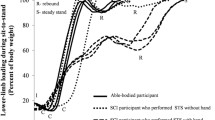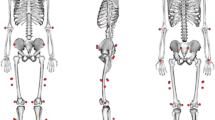Abstract
Background and purpose
Sit-to-stand (STS) task requires the ability to maintain balance while pivoting the body mass over the feet. Following stroke, the rising ability from the seated position is reduced because of difficulty in generating timing and sufficient force in muscles of the trunk and lower limbs to propel the body mass vertically. The aims of this study were to analyze the sagittal lumbar range of motion (ROM) during STS task, calculate the total time of the task, and investigate their relations to balance in patients with chronic stroke.
Patients and methods
Thirty male patients with chronic stroke (mean age: 51.2±3.75 years) were included in this study. They were divided into two equal groups (group I and group II). Group I had a mild degree of spasticity, whereas group II had a moderate degree in the affected lower limb. Lumbar ROM before and after buttock lift-off (LO) and the total time of STS were recorded using three-dimensional motion analysis system. Balance was assessed using Berg Balance Scale (BBS).
Results
The patients in group I showed a significant increase of lumbar ROM before (P=0.02) and after (P=0.03) buttock LO and also in BBS scores (P=0.0001) as compared with the patients in group II. However, there was a significant reduction in STS duration in favor to group I compared with group II (P=0.01). In addition, there was a statistically significant moderate negative correlation between BBS scores and lumbar ROM before buttock LO in both groups (P<0.05) and after LO in group I only (r=−0.69).
Conclusion
Patients suffering from stroke with moderate degree of spasticity show less lumbar ROM at pre-LO and post-LO phases than those with mild spasticity, and took longer time to execute STS task aiming to improve balance and postural stability.
Similar content being viewed by others
References
Farqalit R, Shahnawaz A. Effect of foot position during sit-to-stand training on balance and upright mobility in patients with chronic stroke. Hong Kong Physiother J 2013; 31:75–80.
Fawi GH, Corea F, Abbas MA, Thabit MN, Comi G. Southern Egypt stroke study: Case fatality rates in a hospital-based setting. Open General Int Med J 2009; 3:40–46.
Fotoohabadi MR, Tully EA, Galea MP. Kinematics of rising from a chair: image-based analysis of the sagittal hip-spine movement pattern in elderly people who are healthy. Phys Ther 2010; 90:561–571.
Itoh N, Kagaya H, Horio K, Hori K, Itoh N, Ota K, et al. Relationship between movement asymmetry and sit-to-stand/stand to-sit duration in patients with hemiplegia. Jpn J Compr Rehabil Sci 2012; 3:66–71.
Pinheiro M, Polese JC, Machado G, Scianni AA, Hirochi TC, Teixeira-Salmela LF. Balance analysis during the sit-to-stand movement of chronic hemiparetic individuals based upon their functional levels. Man Ther Posturology Rehabil J 2010; 12:260–264.
Gray CK, Culham E. Sit-to-stand in people with stroke: effect of lower limb constraint-induced movement strategies. Stroke Res Treat 2014; 2014:1–8.
Cheng PT, Chen CL, Wang CM, Hong WH. Leg muscle activation patterns of sit-to-stand movement in stroke patients. Am J Phys Med Rehabil 2004; 83:10–16.
Galli M, Cimolin V, Crivellini M, Campanini I. Quantitative analysis of sit to stand movement: experimental set-up definition and application to healthy and hemiplegic adults. Gait Posture 2008; 28:80–85.
Dehail P, Bestaven E, Muller F, Mallet A, Robert B, Bourdel I, et al. Kinematic and electromyographic analysis of rising from a chair during a sit to walk task in elderly subjects: role of strength. Clin Biomech (Bristol, Avon) 2007; 22:1096–1103.
Bohannon RW, Smith MB. Interrater reliability of a Modified Ashworth Scale of muscle spasticity. Phys Ther 1987; 67:206–207.
Berg K, Wood-Dauphinee S, Williams JI. The Balance Scale: reliability assessment with elderly residents and patients with an acute stroke. Scand J Rehabil Med 1995; 27:27–36.
Tully EA, Fotoohabadi MR, Galea MP. Sagittal spine and lower limb movement during sit to stand in healthy young subjects. Gait Posture 2005; 22:338–345.
Brunt D, Greenberg B, Wankadia S, Trimble MA, Shechtman O. The effect of foot placement on sit to stand in healthy young subjects and patients with hemiplegia. Arch Phys Med Rehabil 2002; 83:924–929.
Nikfekr E, Kerr K, Attfield S, Playford DE. Trunk kinematics in Parkinson’s disease during rising from seated position. Mov Disord 2002; 17:274–282.
Streiner DL, Norman GR, Cairney J. Health Measurement Scales: a practical guide to their development and use. 5th ed. New York, NY: Oxford University Press; 2015.
Gillen G. Trunk control: a prerequisite for functional independence. In: Gillen G, Burkhardt A, editors. Stroke rehabilitation: a function based approach. St Louis, MO: Mosby; 1998. 69–89.
Schultz AB, Alexander NB, Ashton-Miller JA. Biomechanical analysis of rising from a chair. J Biomech 1992; 25:1383–1391.
Lomaglio MJ, Eng JJ. Muscle strength and weight bearing symmetry relate to sit-to-stand performance in individuals with stroke. Gait Posture 2005; 22:126–131.
Vander Linden DW, Brunt D, McCulloch MU. Variant and invariant characteristics of the sit-to-stand task in healthy elderly adults. Arch Phys Med Rehabil 1994; 75:653–660.
Goulart FR, Valls-Sole J. Patterned electromyographic activity in the sit-to-stand movement. Clin Neurophysiol 1999; 110:1634–1640.
Silva A, Sousa AS, Pinheiro R, Ferraz J, Tavares JM, Santos R, et al. Activation timing of soleus and tibialis anterior muscles during sit-to-stand and stand-to-sit in post-stroke vs. healthy subjects. Somatosens Mot Res 2013; 30:48–55.
Silva FC, Rodrigues AM, Wiest MJ. Effects of a subsequent task after sit-to-stand movement on muscle activation and initiation of movement. Braz J Kinanthrop Hum Perform 2013; 15:458–466.
Layne CS, Abraham LD. Interactions between automatic postural adjustment and anticipatory postural patterns accompanying voluntary movement. Int J Neurosci 1991; 61:241–254.
Neumann DA. Kinesiology of the musculoskeletal system: foundations for physical rehabilitation. St Louis, MO: Mosby; 2002: 275–309.
Karatas M, Cetin N, Bayramoglu M, Dilek A. Trunk muscle strength in relation to balance and functional disability in unihemispheric in stroke patients. Am J Phys Med Rehabil 2004; 83:81–87.
Muscolino JE. Kinesiology: the skeletal system and muscle function. St Louis, MO: Elsevier-Mosby; 2006: 278–359.
Bohanon RW, Larkin PA, Smith MB, Horton MG. Relationship between static muscle strength deficits and spasticity in stroke patients with hemiparesis. Phys Ther 1987; 67:1068–1071.
Horstman AM, Beltman MJ, Gerrits KH, Koppe P, Janssen TW, Elich P, et al. Intrinsic muscle strength and voluntary activation of both lower limbs and functional performance after stroke. Clin Physiol Funct Imaging 2008; 28:251–261.
Fridén J, Lieber RL. Spastic muscle cells are shorter and stiffer than normal cells. Muscle Nerve 2003; 27:157–164.
Exner C. Evaluation and intervention to develop hand skills. In: Case-Smith J, O’Brein JC, editors. Occupational therapy for children. 6th ed. Maryland Heights, MO: Mosby-Elsevier; 2010. 275–324.
Lord SR, Murray SM, Chapman K, Munro B, Tiedemann A. Sit-to-stand performance depends on sensation, speed, balance, and psychological status in addition to strength in older people. J Gerontol A Biol Sci Med Sci 2002; 57: M539–M543.
Lee CC, Wang RY, Yang YR. Correlations among balance and mobility measures for patients with stroke. Formos J Phys Ther 2003; 28:139–146.
Author information
Authors and Affiliations
Corresponding author
Additional information
This is an open access article distributed under the terms of the Creative Commons Attribution-NonCommercial-ShareAlike 3.0 License, which allows others to remix, tweak, and build upon the work noncommercially, as long as the author is credited and the new creations are licensed under the identical terms.
Rights and permissions
About this article
Cite this article
Gharib, N.M.M., Rehab, N.I. & Rezk-Allah, S.S. Sagittal lumbar motion during sit-to-stand task and its relation to balance in chronic stroke patients. Bull Fac Phys Ther 22, 59–65 (2017). https://doi.org/10.4103/bfpt.bfpt_50_16
Received:
Accepted:
Published:
Issue Date:
DOI: https://doi.org/10.4103/bfpt.bfpt_50_16




